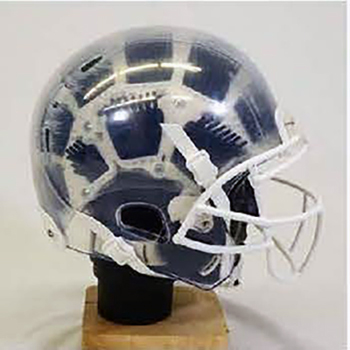Former Biomimicry Fellows Dr. Emily Kennedy and Dr. Bor-Kai (Bill) Hsiung successfully completed the prototyping and testing of a hedgehog-inspired impact protection technology, using funding provided by the University of Akron Research Foundation’s Spark Fund. This marks the successful completion of the second of six projects funded by the Spark Fund, starting in 2017. Kennedy and Hsiung also collaborated with Dr. K.T. Tan, assistant professor of mechanical engineering; Nathan Swift, recent Case Western Reserve University graduate; and Douglas Paige, an industrial design professor at the Cleveland Institute of Art.
UARF’s Spark Fund was established in 2017 to provide resources and support to develop the proof needed to transform UA technology into a validated prototype that can be licensed to a scalable startup company. To date, Spark Fund has committed almost $500,000 in UARF and State of Ohio funding to six projects.

Hedgemon executives, from left, Nathan Swift, Dr. Bor-Kai (Bill) Hsiung and Dr. Emily Kennedy.
The hedgehog-inspired impact protection technology will likely see its first application in football helmets, where its unique ability to damp both linear and angular acceleration could reduce risk of concussions and lessen damage caused by subconcussive impacts. Using Spark Fund support, the biomimicry team optimized the performance of their hedgehog mimicking polymer “quills” design, 3D printed samples for drop tower testing, and created a full football helmet liner that was tested head-to-head against competitive helmets at ICS Labs. The UA technology outperformed top-rated conventional helmets at multiple impact locations and velocities.

Hedgemon helmet prototype.
After the completion of the Spark Fund project, UARF licensed the technology to Cleveland-based startup company, Hedgemon. This is the second technology licensed as a result of Spark Fund activities.
Four other Spark Fund projects are also ongoing:
- a surface coating to resist wear and friction used in mechanical applications;
- a sensor that detects sodium ions in sweat to warn athletes of the onset of dehydration;
- a binder polymer that enables batteries and fuel cells to be manufactured with lower weight and higher energy storage; and
- a novel tire additive that increases tire performance while eliminating environmentally harmful emissions.
Overall, the funded projects come from six different labs and four departments on the UA campus.the
UARF serves UA and the Akron community through entrepreneurship education, technology commercialization, application of UA research, and creation of new entrepreneurial ventures. To learn more, visit the UARF online or email uarf@uakron.edu.
Media contact: Cristine Boyd, 330-972-6476 or cboyd @uakron.edu.
